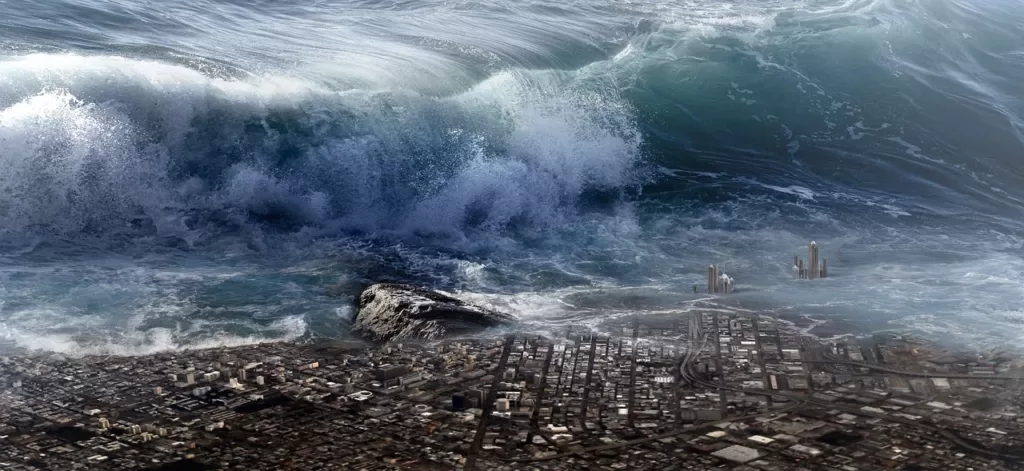Table of Contents
Introduction
Earthquakes are natural phenomena that have fascinated scientists and the general public for centuries. They are powerful forces of nature that can cause significant damage and loss of life. Understanding the science behind earthquakes is crucial for studying and predicting them, as well as developing strategies to minimize their impact. In this article, we will explore the causes of earthquakes, the mechanisms that drive them, and the profound impact they have on our planet.

Image by Angelo Giordano from Pixabay
The Science Behind Earthquakes: What Causes Them?
Plate Tectonics: The Driving Force
Earthquakes are primarily caused by the movement of tectonic plates, which make up the Earth’s surface. The Earth’s lithosphere is divided into several large plates that float on the semi-fluid asthenosphere below. These plates interact with each other along their boundaries, resulting in various geological phenomena, including earthquakes.
When two plates collide, one plate can be forced beneath the other in a process called subduction. This can create intense pressure and friction between the plates, leading to the release of energy in the form of an earthquake. Another type of boundary is where two plates slide past each other horizontally, creating a lateral movement known as a transform boundary. The stress and strain that accumulate along these boundaries eventually cause the rocks to rupture and generate seismic waves.
Faults: The Path of Least Resistance
Faults are fractures in the Earth’s crust along which movement has occurred. They act as the pathways through which seismic energy is released during an earthquake. There are three main types of faults:
Normal faults: These occur when the hanging wall moves downward relative to the footwall, typically associated with extensional tectonic forces.
Reverse faults: These occur when the hanging wall moves upward relative to the footwall, commonly associated with compressional tectonic forces.
Strike-slip faults: These occur when the rocks on either side of the fault move horizontally past each other, without significant vertical movement. The San Andreas Fault in California is a famous example of a strike-slip fault.
Elastic Rebound Theory: The Break and Snap
The elastic rebound theory, proposed by American geologist Harry Fielding Reid in 1910, provides a fundamental understanding of how earthquakes occur. According to this theory, rocks on either side of a fault are subjected to stress and gradually deform, storing elastic energy. Eventually, the accumulated stress overcomes the strength of the rocks, causing them to fracture and snap back to their original undeformed state. This sudden release of energy results in an earthquake.
The elastic rebound theory explains why earthquakes are typically preceded by a period of relative seismic quiescence, as stress accumulates along the fault. When the stress reaches a critical point, the rocks rupture and the stored energy is released, generating seismic waves that propagate through the Earth.
The Role of Seismic Waves
Seismic waves are the vibrations that radiate outward from the source of an earthquake. These waves carry the energy released during an earthquake and can cause significant shaking and damage. There are three main types of seismic waves:
P-waves (Primary waves): These are compressional waves that travel through solids, liquids, and gases. P-waves are the fastest seismic waves and are the first to arrive at a seismograph station. They cause a back-and-forth motion of particles in the direction of wave propagation.
S-waves (Secondary waves): These are shear waves that travel only through solids. S-waves move particles perpendicular to the direction of wave propagation and arrive at seismograph stations after P-waves. They cause shaking and can result in significant damage to structures.
Surface waves: These waves travel along the Earth’s surface and are responsible for the most significant shaking during an earthquake. Surface waves can cause both horizontal and vertical ground motion and are slower than P-waves and S-waves.
How Do Earthquakes Impact Our Planet?
Destruction and Loss of Life
One of the most obvious impacts of earthquakes is the destruction they cause. The violent shaking can damage buildings, infrastructure, and lifelines such as roads, bridges, and power lines. Collapsing structures can lead to casualties and loss of life, making earthquakes a significant threat to human populations.
Tsunamis: The Ripple Effect

Underwater earthquakes have the potential to trigger tsunamis, which are large ocean waves that can travel across entire ocean basins. When an earthquake occurs beneath the ocean floor, it can displace a large volume of water, creating a series of powerful waves. These waves can travel at high speeds and, upon reaching coastal areas, can cause devastating flooding and destruction.
Aftershocks: Lingering Tremors
After the main shock of an earthquake, there are often subsequent smaller tremors known as aftershocks. Aftershocks can occur minutes, hours, days, or even weeks after the initial earthquake. They are the result of the readjustment of stresses in the Earth’s crust following the main event. Aftershocks can be nearly as powerful as the initial earthquake and can further damage already weakened structures.
Landslides and Ground Instability
Earthquakes can trigger landslides in mountainous regions. The shaking can cause slopes to become unstable, resulting in the rapid movement of rock, soil, and debris down a slope. Landslides can bury communities, and block roads, and dam rivers, leading to additional hazards such as flooding and loss of access to essential resources.
Changes to the Earth’s Surface
Powerful earthquakes can have a lasting impact on the Earth’s surface. Faults can rupture and displace rocks, creating visible offsets in the landscape. The land can rise or sink, altering coastlines and elevations. Earthquakes can also trigger the formation of new geological features, such as fissures and cracks in the ground.
Economic Consequences
Earthquakes can have significant economic consequences. The cost of rebuilding damaged infrastructure, compensating for the loss of property, and providing aid and support to affected communities can be substantial. Additionally, businesses may suffer from disruptions to production and supply chains, leading to economic losses at both local and regional levels.
Frequently Asked Questions (FAQs)
Q1: What is the Richter scale, and how is it used to measure the magnitude of an earthquake?
The Richter scale is a logarithmic scale used to measure the magnitude of an earthquake. Developed by Charles F. Richter in 1935, it quantifies the amount of seismic energy released during an earthquake. Each whole number increase on the Richter scale represents a tenfold increase in the amplitude of seismic waves and roughly 31.6 times more energy released.
Q2: Can earthquakes be predicted accurately?
While scientists have made significant advancements in earthquake monitoring and prediction, accurate and precise predictions of earthquakes are still not possible. Earthquake forecasting focuses on identifying areas with higher probabilities of seismic activity and providing early warning systems to minimize the impact on human lives and infrastructure.
Q3: Are all earthquakes felt at the Earth’s surface?
No, not all earthquakes are felt at the Earth’s surface. Many small earthquakes occur deep within the Earth’s crust or at remote locations, where their effects are not noticeable. However, larger earthquakes with significant magnitudes can be felt over extensive areas and can cause widespread damage.
Q4: Can human activities induce earthquakes?
Yes, human activities can induce earthquakes through a process known as induced seismicity. Activities such as mining, reservoir-induced seismicity (resulting from the filling of large reservoirs), and hydraulic fracturing (fracking) have been associated with induced earthquakes. These induced earthquakes are typically of lower magnitude than natural earthquakes but can still pose risks in some cases.
Q5: Are all faults capable of generating earthquakes?
Not all faults are capable of generating earthquakes. Faults must have accumulated sufficient stress and strain over time to exceed the strength of the rocks, leading to rupture and the release of seismic energy. Inactive faults may have relieved their stress through previous earthquakes or have not accumulated enough stress to generate seismic activity.
Q6: How can individuals prepare for an earthquake?
Individuals can take several steps to prepare for an earthquake:
- Create an emergency plan for your household, including designated meeting points and communication methods.
- Build an emergency supply kit with essential items like food, water, medication, and first aid supplies.
- Secure heavy furniture and objects to prevent them from toppling during an earthquake.
- Practice “Drop, Cover, and Hold On” drills to protect yourself during shaking.
- Familiarize yourself with evacuation routes and safe areas in your community.
Conclusion
Understanding the science behind earthquakes is crucial for comprehending their causes and impacts on our planet. The movement of tectonic plates, the role of faults, and the release of elastic energy through seismic waves all contribute to the occurrence of earthquakes. The destruction, loss of life, tsunamis, aftershocks, landslides, and economic consequences are some of the impacts associated with these powerful natural events. By studying and monitoring earthquakes, scientists strive to enhance our ability to predict and mitigate their effects, ultimately making our world a safer place.

